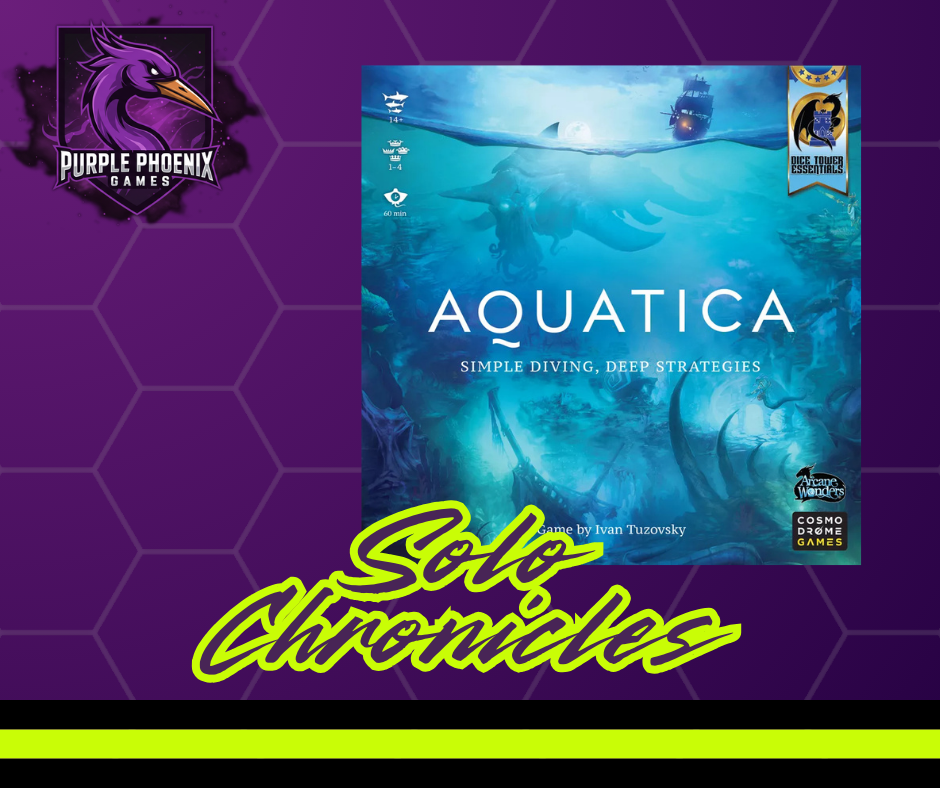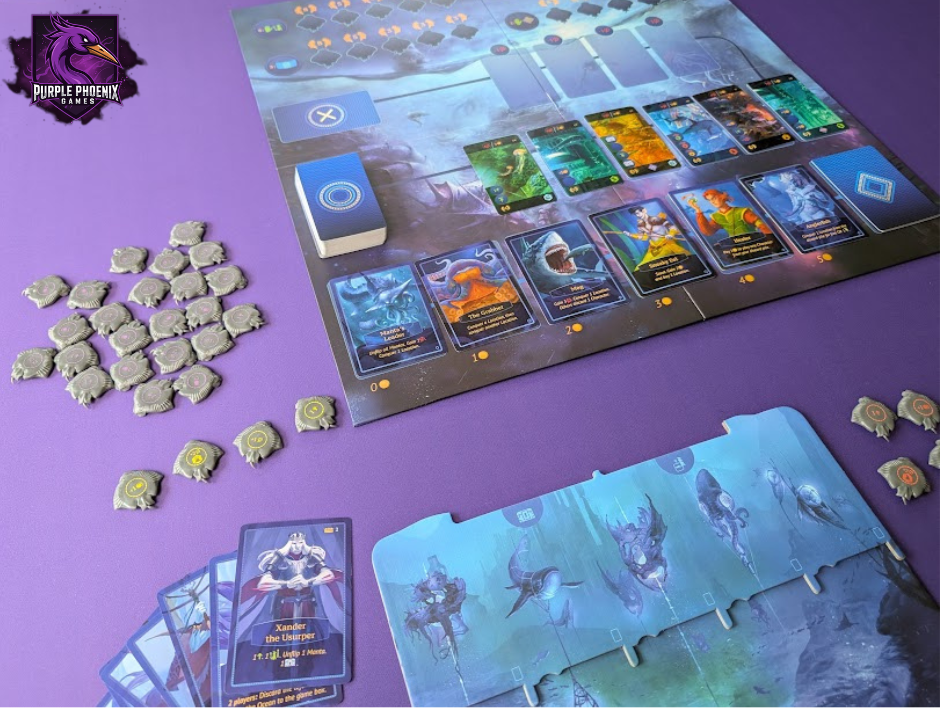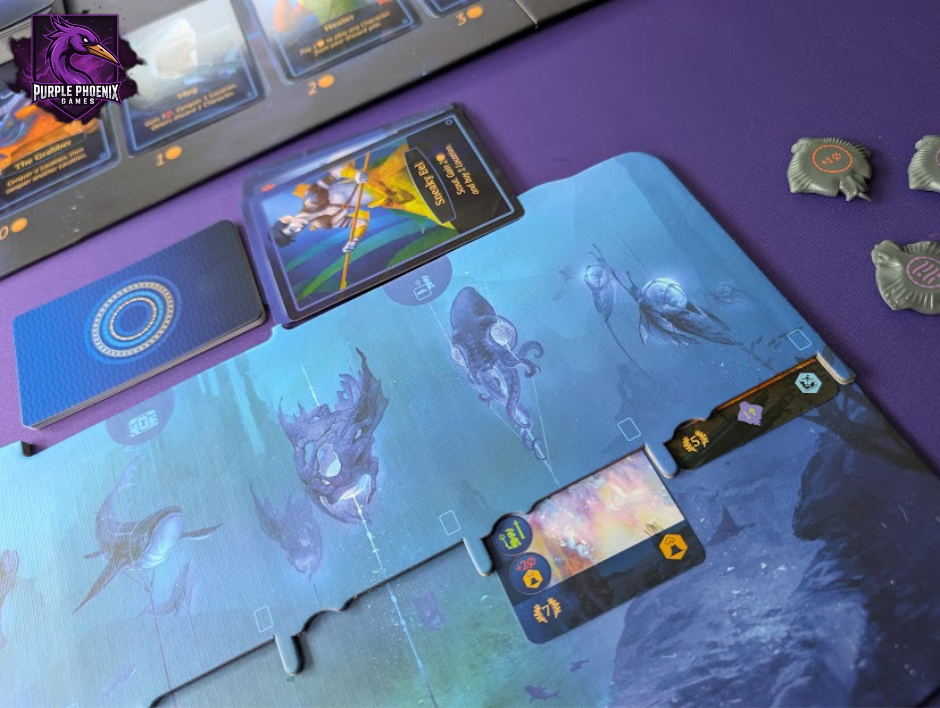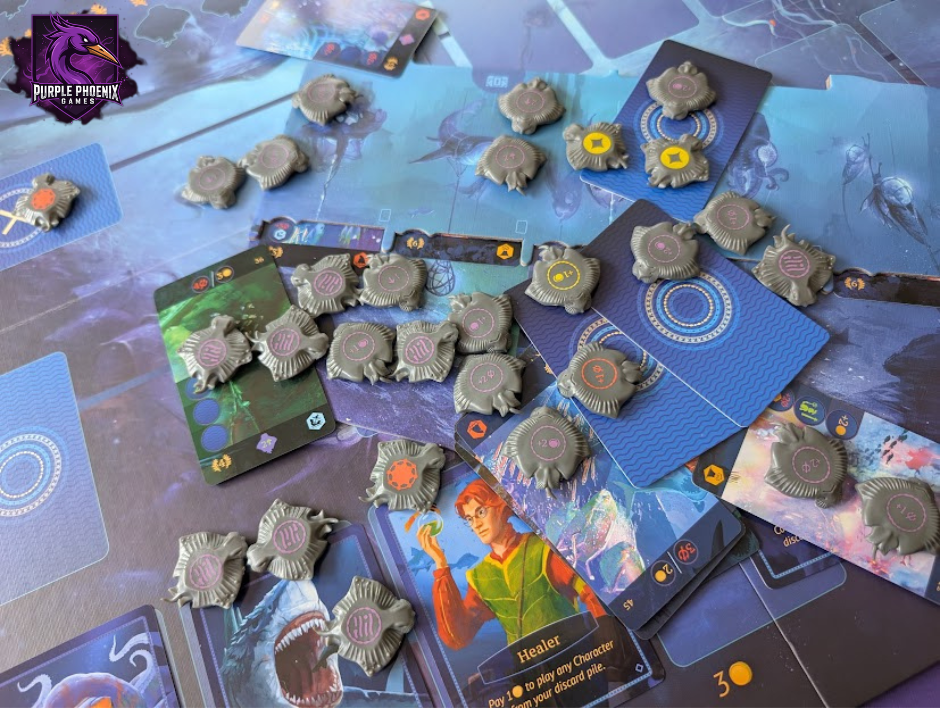
How do you feel when you see a game box with a bunch of icons proving its worth by winning certain design competitions? What about if it has simply one icon? What if that icon is the Dice Tower Essentials? I know Tom and crew at the Dice Tower have been making content for ages and ages now and have brought so many gamers into the hobby. I appreciate them for that. However, emblazoning the Dice Tower Essentials icon on a box is not an auto-buy for me. Don’t get me wrong – they have chosen some excellent games for this group (Onitama, Four Gardens), but some are real stinkers. So will I enjoy this one or toss it on the sell pile?
| Aquatica (2019) | Cosmodrome Games / Arcane Wonders |
| 1-4 Players | 30-60 minutes |
| Ages 12+ | BGG Weight – 2.30 / 5 |
Aquatica is an underwater open drafting, hand management game with some very slight deck building elements. In it, players are simply attempting to gain the most amount of points by the end of the game, and these points are earned in three ways. For this review I am playing with the official solo rules included in the rulebook.
To setup the solo game, place the beautiful main board wherever you want (I’m just tired of games telling me to put it in the middle of the table). Shuffle the 56 Location cards (with the circular icon on the back) and place out six of them in their slots on the middle of the board. For the solo game, remove one set of the Ocean Character cards, shuffle them, then place six in their slots at the bottom of the board. Shuffle the King cards and deal yourself one, or simply choose your favorite. Place out a player board for yourself. Choose a color of mantas and the matching Starting Character cards. Place the Wild mantas somewhere nearby, and one set of a different color of four mantas representing your opponent. The game is now setup and ready to begin!

Aquatica is played over several turns, and the solo game also feels like the player is simply playing against the board instead of another player. On the player’s turn they must complete one Main Action and then as many Additional Actions as they like. The Main Action is simply choosing a Character or King card from hand, performing all the actions printed on its card, and then discarding it above the player board. These cards could allow the player some coins or power with which they may purchase or conquer locations, or even raise and score locations already in possession. Let me explain.
The player is trying to score the most amount of points by the end of the game. One of the biggest ways to accomplish this is to acquire Location cards from the board and “raise” them in order to score them for VP. On the left side of Locations cards are typically printed one or more circular icons that can provide resources, raise other Locations, retrieve Character cards, score Location cards, or several other things. The photo below shows two Location cards in play. The left one is currently set to retrieve discarded Character cards when used, by sliding the card up further into the double layer board, while the card on the right is primed to be scored. That card has been raised to its furthest level and will provide the player five VP and a Wild Manta.
Speaking of Mantas, the player is given their set of four Mantas, each providing the player with benefits: 1 coin, 1 power, 1 raise ability, or even more with the Wild Mantas’ abilities. In order to use their abilities, simply flip it onto its belly to show that it is tired. Certain cards will instruct the player to “flip all Mantas,” thus allowing the Mantas to ready themselves for usage.
With the help of these friendly Mantas, the abilities given from Character cards, and abilities used on owned Location cards, the player can take any number of Additional Actions after playing a Character or King. They can simply spend coins to Recruit a Character from the bottom of the board, paying the cost printed below the card. Once Recruited, all Characters fill in the space by moving to the left and then flipping the next Character from the deck. The player may also choose to buy or conquer a Location from the available Locations in the middle of the board. To buy, the player will use coins. To conquer, the player will need to use power. Power is given from Character, owned Locations, and even some Mantas. Spend these by flipping Mantas, or raising a Location card from the player board. An upvote arrow icon will allow the player to raise one or more Location cards to reveal the next action bubble, or wipe out the card completely, making it prepared to be scored. To score a card, utilize the treasure chest icon to score a Location that has been fully raised by removing it from the player board and placing it into the score pile above the player board. Finally, the player may Scout by sliding the available Location cards up to the scouted location slots and revealing six more Locations from the deck. These are immediately available to buy or conquer.
When playing solo, the pressure of the ghost player comes from when a certain Character card is played or when the player chooses to Scout. When the Matrona card is played, it allows the player to retrieve ALL Characters from the discard pile and unflips all Mantas to their readied status. If either the Matrona card is played or the Scout action is taken, the ghost player earns the opportunity to place one of their four special Mantas up on the top of the board where the four Goals can be achieved. In the solo game, the four Goals will provide either eight or five points to the player who completes them first or second, respectively: A) having eight cards in hand, B) having five Locations on the player board, C) having three or more Locations in the score pile, and D) having two or more Wild Mantas.
The game ends when one of these three scenarios are met: a player has completed all four Goals, the Location deck is depleted, or the Ocean Character deck is depleted. The solo player then scores one point for each Character in hand, the appropriate points earned for completed Goals, and points earned on each of the Location cards that have been scored during the game. The player then checks their total against the table in the rulebook. Not to brag, but I got over 100 points in my first game. More than likely I missed something or inadvertently cheated somehow. But I wrote it down anyway.

Components. The components in this game are absolutely AMAZING. The art is gorgeous throughout, from the board, all cards, and even the rulebook looks great. The quality of all the components is fabulous as well. The cards are great, the boards are all super sturdy, and those Mantas are so much fun to fidget with whilst playing. I am not surprised that an Arcane Wonders game provides super high quality components. It’s more expected now.
Now, did I enjoy this solo? Yes, but dang I wish there was a better way to deal with the endgame instead of the ol’ “beat your last score” that seems to plague other games as well. I am simply not intelligent enough to come up with a fix for it, so I cannot complain, really, but otherwise this is a stunning and very well-designed game – even the solo mode. I enjoy the theme so much, and it gives me Abyss feelings, which isn’t at all bad, but do I need both in my collection? Abyss has underwater factions, leaders, great art, and pearls. This one has all that minus the pearls, but plus the cool Mantas. I am going to be giving this some serious thought, because as I age I am feeling that maybe I DON’T need every game I like, but rather keep only the absolute bangers in my collection. Which do I prefer? Do I keep both?
Ultimately, Aquatica certainly surprised me with its aesthetics, extremely high production quality, and easy rules to follow. It all makes sense, and it makes me happy to play. If you are looking for something a little bit different and you enjoy a great looking game that has an official solo mode (Abyss has unofficial modes found at BGG), I urge you to give this one a look. And please, someone help me decide whether to keep both or whittle down to just one. And which one? I can’t be expected to make these tough decisions! I’m too busy! But let me know. Please. And thank you.

